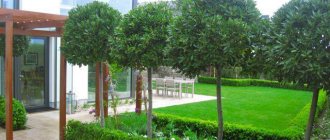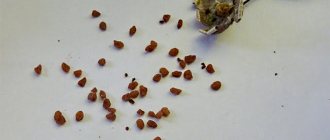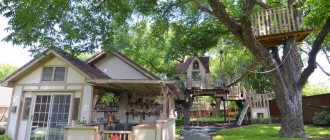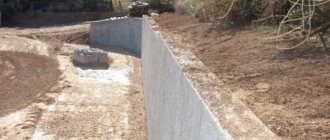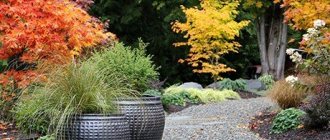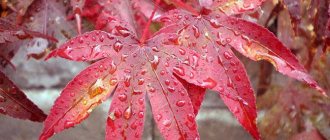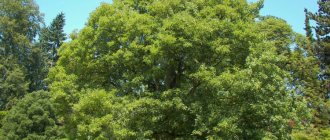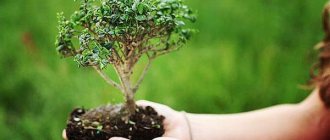Amateur gardeners and landscape designers are sensitive to rare ornamental plants. The Japanese maple can become the pride of every garden. Its natural distribution range is limited to the islands of Japan, the South Korean coast and the Russian island of Kunashir. It grows more often in mountainous areas.
Growing this tree crop requires certain knowledge and precautions. How to properly plant and care for a heat-loving plant.
In natural landscapes - a deciduous tree or shrub up to 10 meters high. The bark and branches are colored reddish-gray and are smooth.
The leaves are like those of our maple - dissected to half the diameter into several segments (from 7 to 11), large (coverage up to 15 centimeters). Depending on the variety, the dissection of the leaves can be different, sometimes they are very feathery. The petioles on which the leaves grow, 3-5 cm long, may be pubescent.
Due to the magnificent color of the leaves, this type of maple has become so popular; the crowns of the Japanese beauty fly like red flames in the middle of the garden. Some of its species have a crimson-red foliage throughout the growing season, others change color from green to yellow and crimson.
The bright, small flowers appear earlier than the leaves in spring. From them lionfish are formed. These are seed fruits up to 3 centimeters long, with the help of which plants of this genus reproduce.
Eastern maples are grown in open ground and in special tubs.
Types and interesting varieties
Japanese maple has several subspecies, and breeders have developed amazing varieties that no one can pass by indifferently. They differ in the shape of the tree and leaves, and their demands on living conditions. There can be both tall and short specimens.
It should be noted that culturally bred varieties are much more picturesque and are found much more often than basic natural varieties. In addition to the main species described above, others are also grown.
Fan-shaped (palm-shaped)
The tree, original in shape, has a spreading crown with beautiful, carved leaves. The long-lobed leaves have a lacy outline and remain golden yellow or red throughout the season. Having shed its foliage, this plant remains a decoration of the garden, thanks to its graceful branches. It blooms red in June; many varieties have been created based on it.
Shirasawa Maple
A rare variety up to 15 meters high, there are shrubs with a low-growing outline. The leaf blade is not very dissected, large. A striking representative of this species is Aureum. This shrub grows up to 4 meters high and has a yellow-orange leaf with a border around the edge. The variety is quite winter-hardy, but they also like to cultivate it in tubs.
Aconitofolia
Gorgeous maple, almost completely dissected leaves are green in summer. In autumn the tree turns purple.
Orange Dream
Yellowish-green leaves with a red border are painted in a red-orange color. Orange Dream grows quickly and is tall.
Bloodgood
A very decorative shrub with delicate outlines of dark red leaves, almost inky in color. Even in the shade it does not lose the dark color of the foliage.
Mikawa yatsubusa
Height 1.5 meters, bush dense and squat. The leaves are needle-shaped, green in spring, scarlet in autumn.
Shaina
One and a half meters in 10 years - this is the height this tree grows. It is distinguished by a dense bushy crown, its leaves are deeply cut. When it turns blood red in color, it becomes especially attractive. Shaina is planted in containers, decorating terraces and verandas, and the halls of houses.
Kiyohime
The Japanese red maple variety reaches 1.8 meters in adulthood. Green leaves are edged with red and cut. Retains color saturation in partial shade.
Beni Kawa
The leaves are light, the original red bark.
Dissectum Garnet
The finely dissected conifer-like leaves are green in spring, becoming reddish-purple or orange-yellowish in autumn. The huge crown coverage, almost twice the height, gives the tree a very beautiful, attractive appearance. Such drooping varieties of shrubs should be placed near ponds or gazebos.
Aka shigitatsu sawa
The tree is 3 meters or so tall. This plant has peculiar pink or red dissected leaves. Loves partial shade.
Wilson's Pink Dwarf
The fan maple variety is not very winter-hardy. The height of the bush in adult form is 2.5 meters, the coverage is 1 meter less. The leaves grow on red branches and are orange in color.
Shirazz
Deeply dissected green leaves with pink or red borders give a spectacular appearance. Towards the end of the season it changes color to purple.
Red maple Acer rubrum
Red maple is truly a favorite of landscape designers for its variety of shapes and bright colors at any time of the year. This is an unpretentious, long-lived, frost-resistant and shade-tolerant tree, perfectly adapting to various difficult soils and polluted, polluted air. With good care, it practically does not get sick and is little susceptible to attack by pests. The only thing this maple does not tolerate is excessively dry soils. Autumn color depends on soil and weather conditions.
Some of the forms and varieties of this deciduous tree “flare up” with a warm color only in the fall, remaining usually green in the spring and summer. Others, even in the warm months, simply glow in the area with various shades of yellow and scarlet, thanks to which they look great in solitary plantings and do not get lost in dense general thickets. Let's look at some popular ornamental varieties of red maple.
Red maple Summer Red (Summer Red)
This maple is valued for its uneven leaf color throughout the season. Its young leaves are red or purple with dark burgundy long petioles; when fully bloomed, they are dark green above and bluish below; in autumn, the heterogeneous color on one leaf varies from green-golden-orange to burgundy-purple.
An adult tree grows up to 10-15 meters. The crown is narrow or rounded pyramidal, dense, uniform. The bark is dark gray, smooth. The leaves are medium-sized, three-lobed, hard, glossy.
Red maple October Glory
“October Splendor” is how the name of this maple can be translated, and it was not given in vain. Its leaves are bronze-red when blooming, then become light green with a bluish underside, and in the fall they acquire a bright red (usually) or orange-red color.
An adult tree grows up to 7-15 meters. The crown is wide-pyramidal, dense, uniform. The bark is gray-brown, smooth, and becomes slightly cracked with age. The leaves are medium-sized, three- or five-lobed, with jagged edges, hard, shiny.
Red maple Armstrong (Armstrong)
This fast-growing maple is distinguished by foliage that, when blooming, is carmine red, then intense green on reddish petioles, and bluish below. Autumn color is bright - from yellow, orange to purple-red tones with a pinkish-silver “backing”.
An adult tree grows up to 10-15 meters. The crown is columnar or ovoid, dense, uniform. The bark is gray-silver, smooth, becoming slightly cracked with age. The leaves are medium-sized, five-lobed, smooth, shiny.
Red maple Scanlon (Scanlon)
The leaves of this maple, when blooming, are reddish on the same red petioles, then in the summer they become rich green on top (greenish-gray on the underside), and in the fall they acquire an orange-red or red color, sometimes with a purple tint.
An adult tree grows up to 9-12 meters. The crown is narrow-columnar or narrow-pyramidal, dense, uniform. The bark is dark gray, flaky, the branches are brownish-red. The leaves are medium-sized, three- or five-lobed, smooth, shiny, with finely toothed edges.
Where to buy seedlings, where and how to plant
You should not buy Japanese maple seeds online from unknown sellers. It is advisable to come to a nursery or store engaged in certified sales and buy a tree.
It is better to purchase a seedling in spring or autumn; you need to make sure that the bush is not damaged. It must be planted immediately.
Japanese maple varieties love diffused shade and permeable soil. There is no need to choose too alkaline soils and treat the soil with lime.
The soil should be fairly fertile or slightly acidic, and always loose.
Landing
- A hole is dug twice as large as the root system of the plant;
- Pour drainage into the hole, then humus or compost with peat;
- Moisten and straighten the roots, place the tree, sprinkle with soil and water;
- To preserve moisture, mulch the tree trunk area.
Reproduction
Produced by seeds, both in nature and under cultural conditions. Seed material must be fresh.
- Before planting, the seeds are stratified by placing them in sand (it should not be wet) and kept in a cold room all winter;
- In spring they are planted in containers with special soil; they can be treated with growth stimulants;
- In autumn, the strongest shoots are left to overwinter in a cool place in the same container, where the temperature is always above zero;
- Next spring, transplant the shoots into separate pots;
- Plant seedlings that have reached 30 centimeters in a permanent place - in open ground, a tub or a pot.
Japanese red maples can be propagated vegetatively - by grafting cuttings onto palm-shaped rootstock. This procedure often ends in failure.
Landing
In order for the Japanese maple to take root on the site, planting must be as competent as possible, taking into account all the conditions that this ornamental plant will require.
General recommendations:
- Make sure the soil is not alkaline.
- Loves light humidity, but not stagnant water. Drainage is a must.
- The landing site should be slightly shaded, but such that it is exposed to sunlight for at least a few hours a day.
- One of the most important points when planting is to protect it from drafts by planting it against a wall or hedge, or, as an option, to protect it with conifers.
- If several seedlings are planted at the same time, they should be at least 2-3 m apart from each other, since the plant has a fairly spreading crown.
Propagation by seeds
The best option is to grow from seeds at home. The algorithm is simple:
- soak the seeds for 2-3 hours;
- fill small containers (10x10) with fertile soil;
- place the seeds to a depth of about 5 cm (each seed in a separate hole);
- cover with film or glass;
- put in a well-lit place, but so that there is no direct sunlight;
- remove the shelter for ventilation for a couple of hours every day;
- wait for the first leaves and plant the seedlings in open ground (or in a tub).
Rules for planting seedlings:
- the depth of the planting hole should be twice as large as the root system of the seedling;
- organize drainage;
- if the soil is clayey, add sand;
- immerse the seedling in a solution of any rooting agent for literally a quarter of an hour;
- place in a hole, carefully straighten the roots;
- sprinkle with pre-prepared soil mixture: soil + peat + compost;
- create a tree trunk circle by compacting it;
- water generously;
- apply fertilizer the next day;
- mulch the tree trunk circle.
If you don’t have time to bother with seeds, you can buy a seedling. But in this case, you need to carefully examine it for the presence of diseases and strength. The weak will not survive.
Propagation by cuttings
Propagating Japanese maple by cuttings is a troublesome undertaking and does not always end in success. The survival rate in this case is quite low compared to seeds.
- In the spring, choose a strong but young branch on which the bark has not yet formed.
- Make a circular cut at its base - this is where the root system will develop.
- Make a second similar cut a little higher (at a distance of 2-3 cm).
- Remove thin skin between cuts.
- Apply root-forming hormone (available in the form of powder or gel) to this area.
- Attach sphagnum moss (previously moistened abundantly) to the treated cut (it activates the necessary hormones).
- Seal with polyethylene.
- Leave in a dark, cool place.
- After 3-4 weeks, roots will appear through the applied bandage.
- The bandage is removed and the cuttings, which have taken root, are planted in the ground.
It is often propagated by grafting onto palm maple. But only experienced gardeners can do this.
Care
Domestic gardeners plant low-growing varieties of Japanese maple. If it grows in a container, it needs to be fed regularly with mineral compounds. Fertilizers for heather crops are suitable. It will also need more frequent watering.
The roots of the plant do not like stagnation of water, they can rot. Therefore, watering should be abundant but timely.
On old and dense trees it is necessary to carry out anti-aging pruning. It is done in the fall, after the leaves have fallen. Sanitary removal of broken and diseased branches is carried out every year in the spring. It is also necessary for the prevention of fungus.
Preparing for winter
In the summer you need to start preparing the maple tree for winter. Finish fertilizing, watering and loosening. In late autumn, remove all leaves from the bush, and after the first frost, spray the branches with a weak (3%) copper-containing solution.
In the northern regions of Russia, it is still safer to plant this crop in tubs and bring it into a cool room for the winter. It is also practiced to overwinter directly in pots laid on their sides in the garden, in a shallow trench.
In the middle zone, they practice covering for the winter with garden non-woven material. It’s good if the winter is snowy, then the maple can survive it stably.
Spring care
With the arrival of spring, it is necessary to awaken the tub plant so that it quickly adapts and begins to grow. To do this, after the frosts have gone, on warm days the tree is shed with a large amount of water.
Attention! Tender young leaves will inevitably get sunburned in spring. To prevent this, the potted plant is placed in partial shade or covered, just like an open ground plant, with a light covering material.
Japanese maple in landscape design
Its low growth allows it to be successfully grown in containers. The advantage of this method is that the container can be moved from one place to another, saving it from the sun or removed for the winter, and also from time to time placed in different parts of the garden.
Pots are also placed on stands to make them more visible. Need I mention that the slow-growing tree is used to create bonsai. They are formed by special cutting, using wire and other techniques.
The home location of the maple dwarf is favorable for indoor air. It moisturizes, gives oxygen and pleases with flowering.
Red maple is an excellent partner for other garden plants in the garden. It does not have a very powerful root system and does not suppress nearby crops.
Combines with shrubs, flowering and cereal crops. The garden’s exclusive appearance is given by its proximity in the autumn, when the green leaves of other trees stand next to the purple and orange caps of the “Japanese”.
Rocky Japanese-style gardens, rock gardens, rock gardens, the roof of a building, a lawn - everywhere the maple tree will be the central figure. These beauties can also be planted along walking paths.
The surrounding area and the banks of small artificial reservoirs can be decorated with a picturesque bush planted nearby.
Kingdom:
Plants
Division:
Flowering
Class:
Dicotyledonous
Order:
Sapindaceae
Family:
Sapindaceae
Genus Maple
Species:
Japanese maple - Acerjaponicum Thunb.
A brief description of.
Maple Japanese - a deciduous tree 7-10 m tall, with an openwork crown, dark red one-year-old shoots and almost round 7-11-lobed leaves. Blooms in June.
Spreading.
Japanese maple is a very rare species; in Russia it is known only from two locations in the south of Kunashir Island, South Kuril region, Sakhalin region. Found scattered along the stream. Border and in the district of the river. Dark, gravitating towards the Sea of Okhotsk, warmer and sunny side of the island (1, 2). The main part of its range is located in Japan (Hokkaido and Honshu islands), where the species occurs both in natural conditions and is widely cultivated (3).
Features of ecology and phytocenology.
Japanese maple grows in mixed forests on mountain slopes, often as single small trees.
Number.
The approximate population size is about a dozen individuals. State of local populations. The population is extremely small. Seed regeneration was not observed on Kunashir Island, however, in October 1999, one fruiting plant was discovered.
Limiting factors
.
A small number of individuals in a population. Lack of seed regeneration (4). Security measures taken. Was included in (1988). The species is listed in the Red Book of the Sakhalin Region. (2005). Protected in the Kurilsky Nature Reserve.
Necessary security measures.
Search for new locations of the species and counting the size of the island population. Monitoring the state of the species population. Cultivation possibilities. Cultivated in botanical gardens of Russia: Moscow (GBS RAS, MGUDSHA), Samara, St. Petersburg (GLTA), Selivanovo (b). Due to its decorative properties (large purple flowers and beautiful foliage), it deserves wider introduction into green building (4), including in the south of the Russian Far East.
Information sources.
Red Book of the Russian Federation. 1. Alekseeva, 1983; 2. Data from N.A. Eremenko; 3. Nedoluzhko, 1987; 4. Kharkevich, 1988; 5. Barkalov, Eremenko, 2003; b. Plants of the Red Book..., 2005. Compiled by: V.Yu. Barkalov, N.A. Eremenko. Red Book of the Russian Federation (and mushrooms)
For bonsai connoisseurs, maple, sakura and mountain pine are real symbols of this ancient art. But if evergreen pine needles make the tree’s appearance unchanged throughout the year, sakura is especially attractive in the spring, during flowering, then maple is a bright palette of autumn with unusual openwork foliage.
Maples are distributed throughout the northern hemisphere. Bonsai culture is traditionally dominated by Far Eastern, Chinese and Japanese varieties, but the growing popularity of this area of plant growing has made it possible to include varieties from Europe, the Caucasus and the North American continent in the list of species.
general description
Japanese red maple is a common collective name that covers different types of maples, whose homeland is Japan (Honshu, Kyushu, Hokkaido) and South Korea. This is a perennial deciduous woody plant. Low - in natural growing conditions. In landscape design, both low-growing, dwarf maple (up to 1.5 m in height) and fairly tall ones (can grow up to 10 m) are used. In 1784, J. A. Murray gave a complete botanical description of it based on the unpublished work of the Swedish naturalist Carl Thunberg.
The shoots are reddish-gray, smooth.
Japanese maple leaf:
- rounded;
- serrated (the tips have small oblique teeth);
- opposite (when two leaves arise from each stem node, located opposite each other);
- slightly pubescent with small fibers;
- diameter - up to 15 cm;
- cut to half the diameter or almost to the petiole (this depends on the variety);
- 7-, 9- or 11-beat;
- rests on a thin petiole of medium length - up to 5 cm;
- the color in summer is calm green, in autumn it is bright carmine, luminescent red, poisonous scarlet, crimson with yellow and orange splashes.
It is the shape of the leaf of the Japanese palmleaf maple, or fan-shaped, or palmate, that owes its name.
Flowers:
- in long drooping scutes;
- pubescent;
- length - about 3 cm;
- flowering - from April to June;
- color - bright, violet-red, or pale, green-yellow (depending on the variety);
- then they turn into lionfish (fruits), which hang under the leaves throughout the season.
Distribution area: mixed forests on mountain slopes. Under natural conditions on the territory of the Russian Federation it grows in one and only place. This is Kunashir Island - Yuzhno-Kurilsky district of the Sakhalin region. Due to the small number of individuals in the population and the lack of seed regeneration, it is listed in the Red Book of Russia.
In Japan, October, when Japanese maples acquire their bright colors, is called momiji (translated as red leaves) time.
Types of maple for growing bonsai
Particularly valued are plants with small foliage and short internodes, which allow you to create miniatures that are unique in shape and harmonious, natural in appearance.
Among the species suitable for growing bonsai are Japanese and Norway maples, Montpelian, field and rock maples. Palm maple trees with intricately cut leaf blades are in particular demand. The leaves of this species remain red, contrastingly edged, light yellow or purple not only in autumn, but throughout the year. This species should not be confused with the red maple, also grown as a bonsai. Its five-fingered leaves gradually change their appearance and the appearance of the crown as a whole in autumn. From the USA and Canada, the ash-leaf maple, which is easy to shape, unpretentious and also has varieties with variegated or silver foliage, has come into the sphere of interest of bonsai connoisseurs.
It is not surprising that small trees with red, yellow or any other bright foliage are most attractive to gardeners. Therefore, unscrupulous sellers often “play” on this by offering blue maple seeds for bonsai. There is no need to believe empty promises. If shoots appear from such seeds, at best they will turn out to be an ordinary maple with green leaves. Although it is impossible to grow a blue maple, bonsai with purple, carmine, red or orange leaves are a reality.
There are many examples of varieties used for red maple bonsai, however, due to the low chlorophyll content that supports the nutrition of the tree, such plants are weaker than their green counterparts and require special attention.
Decorative forms more often suffer from sunburn, frost and cold wind, and their brightness directly depends on the choice of location. In the shade, red, burgundy and crimson shades may disappear.
Another highlight of the Japanese maple bonsai is plants with strongly dissected leaves reminiscent of palm branches. These types look great in cascading, flowing compositions, but are not suitable for beginners due to their rather capricious nature and soreness.
But dwarf maple varieties for bonsai are unpretentious and seem to help a person with their formation. They do not tend to grow upward, but form a dense crown covered with small foliage that preserves its natural appearance.
Planting maples
Dwarf maples grow well not only in illuminated spaces, but also in partial shade. But, when choosing a place for planting, you need to take into account the fact that in insufficient lighting, color saturation is lost.
The next point is location. For full development, maples need space. Therefore, when planting in groups, you need to maintain a distance of one and a half to three and a half meters, depending on the variety of maple being planted.
Now the landing hole. It should be deep enough, about seventy centimeters. To ensure good moisture conductivity, a drainage layer about ten centimeters thick made of broken brick, pebbles and river sand is laid on the bottom.
The next stage is soil preparation. Maples need light and nutritious soil. Therefore, you need to prepare a substrate of the following composition:
After the preparatory work, you can proceed directly to planting maple seedlings.
Currently reading:
Features of growing squash
Jan 15, 2022
Features of growing potatoes in bags
Jan 14, 2022
And so, the prepared pit must be filled halfway with water and allowed to soak in, then it is filled two-thirds with the prepared substrate and 150 grams of nitroammophoska is added. The maple seedling is placed in a hole, the roots are carefully leveled, then the space is filled with substrate so that the root collar is at ground level. Afterwards, the soil is trampled down and watered, and the root circle is mulched with peat and sawdust.
There are varieties of Japanese maples, the height of which does not exceed one and a half meters, and such specimens are successfully grown in special flowerpots and pots. They are used to create interiors for large terraces, living rooms, and small areas. For such plantings, choose large ceramic or clay pots, which are filled with light, nutritious soil with sand and a large amount of humus.
Maples can be planted in the garden using seedlings that are sold in specialized stores or grown independently from cuttings or rootstocks.
Conditions for growing maple bonsai
Maples feel good in central Russia, but in the form of bonsai this tree suffers more from external influences and needs to carefully choose a place of residence.
The most common maples in bonsai, palmate and fan maples, can become sick and experience growth difficulties:
- under direct sunlight, especially in the southern regions;
- in the wind or drafts;
- in dense shade.
However, if we are talking about a choice between light and shadow, it is better to expose the pot to the sun, which in the central part of the country will not cause serious harm. In the sun, the tree produces smaller leaves, which eliminates the need to remove buds and does not weaken the plant. In addition, the colors of foliage in full sun are brighter and more attractive.
If in the summer, as in the photo, a maple bonsai is taken out into the open air, it must be protected from the wind, otherwise a plant with a trimmed root system risks losing its balance and falling out of the shallow pot.
Maples, both in nature and at home at low temperatures, do not tolerate excessive air humidity and insufficient flow of fresh air. Under such conditions, bonsai are affected by harmful fungi that cause powdery mildew and anthracnose.
Watering is a mandatory and very important part of caring for a maple bonsai. In summer, the intensity and frequency are increased, and if necessary, careful sprinkling is used. In winter, when the leaves fall and the plant goes into hibernation, the need for moisture drops sharply.
In the spring, when the maple awakens, it is fed, and the presence of iron in the mixture is important for the maple. This is also taken into account when preparing the substrate. The soil for maple bonsai should be nutritious, aerated, with a neutral or slightly acidic reaction. In addition to traditional components, a clay substrate for bonsai is added to the soil, which provides anchorage for the root system and structures the earth mixture.
Replanting and replacing the container when growing maple bonsai coincides with pruning the roots, which is carried out every 2-3 years. In parallel with the formation, dead or damaged rhizomes and lumps of adhering soil are removed.
Caring for Japanese Maples
Caring for dwarf maples is not that difficult. It is important to strictly follow the landing rules:
Maples need regular watering. In summer, if there is no rain, they need to be watered once every seven days. One plant requires about twenty liters of water. At normal humidity, maples can be watered once a month.
Also, during dry seasons, trees respond favorably to spraying their crowns with water. It is recommended to perform this procedure in the evening hours.
To maintain the decorative quality of Japanese maples, they need to be fed periodically. This is done in the spring, before the buds open. During this period, maples need to be fed with urea, potassium salts, and superphosphate.
The ground around the trees must be regularly cleared of weeds and loosened, thereby ensuring access of oxygen to their roots. You also need to periodically mulch the soil around the tree trunk. For this you can use peat or humus.
The crown of maples has its own natural, original shape, so pruning it involves removing dry and damaged branches, which is not particularly difficult even for novice gardeners.
To ensure the safety of trees in winter, they need to be covered, especially when it comes to young specimens and snowless winters.
Trees at the age of one or two years should be covered with spruce branches around the root collar and the trunks should be wrapped in burlap. As maples mature, they develop stability and over time will not need shelter.
Propagation of maple for bonsai
All types of this plant are easily propagated by cuttings and rooted layering. Seeds, which should be stratified before sowing, are also suitable for growing maple bonsai.
To do this, the seed is dropped into damp sphagnum, sand or sand, after which the container with the seeds is sent to the refrigerator. To prepare palm maple seeds, for example, 3–4 months in the vegetable compartment is sufficient. When warmed, the shell will certainly open, and friendly shoots will appear.
Hatched maple seeds for bonsai are transferred to a sand-peat mixture or planted in well-moistened peat tablets. In a greenhouse in the light, but not in the direct rays of the sun, the plant produces a pair of true leaves within a month.
When their number reaches 4-5, it is time to transfer the young maples into their own pots and begin forming a bonsai.
Diseases of Japanese maples
The decorative properties of dwarf maples can be significantly spoiled by various diseases and garden pests.
Most often, maples are affected by:
Shoots affected by the disease are removed, and the trees must be treated with copper sulfate, sulfur solution or other fungicidal preparations.
If not properly cared for, trees can be attacked by pests such as whiteflies, mealybugs, and leaf weevils. If they are detected, maples must be treated with insecticidal preparations.
Techniques for forming a maple bonsai crown
How to grow a maple bonsai without pruning and pinching the crown? This is impossible. These techniques, along with the formation of stems using wire, are an integral part of the ancient art.
Branches are pruned when up to five pairs of full-fledged leaves open on the shoot. Usually they are shortened by 2–4 leaves, and large leaf blades are plucked out separately, leaving their cuttings.
Over time, the cuttings will wither and fall off, and too large leaves will be replaced by small ones that are more appropriate for bonsai. In mid-summer, healthy trees with green foliage are defoliated or plucked out the growth buds, which will lead to:
- to growth retardation;
- to the gradual formation of shorter shoots;
- to increase crown density.
This operation is not performed on red maples for bonsai because it can weaken the already sensitive plant.
It is better to carry out all procedures related to pruning not in the spring, when sap flow is active, but in the summer or autumn. The same applies to the artificial aging of maples grown for bonsai. In the second half or at the end of the growing season, the wounds heal better and the tree recovers better.
Bonsai from Japanese palmleaf maple - video
Japanese maple is a perennial ornamental tree grown in the Land of the Rising Sun. Large lobed leaves are green in summer, and in autumn their color changes to an unusual red. You rarely see it in our latitudes. But, having seen this tree, you will not resist the temptation to have it in your garden or at your summer cottage.
Maple attracts attention with its unique appearance. In order for it to please you for a long time, you need to carefully study the recommendations for growing and caring for the tree.
Varieties of maple with variegated foliage
Growing no more than three meters in height, field maple Carnival
will add lightness and sophistication to your garden landscape. Delicate greenish leaves have an unusual milky cream edging. Even sometimes the light color dominates and from a distance it seems as if the tree has a white crown. When the wind sways the leaves, greenish shades appear a little more and the landscape comes to life before our eyes. Low and slow-growing, this maple will add zest to any landscape composition.
Norway maple Drummondii
It can grow up to 12 meters in height and has a dense, wide-pyramidal crown. Like Carnival, this variety is notable for its incredibly beautiful variegated foliage. An uneven whitish stripe borders the light green large leaves of the Drummondi maple. Its young leaves have a delicate pinkish color. This maple will be a worthy backdrop for plants with dark green or red foliage. It has good winter hardiness, but is very sensitive to soil drying out.
The Flamingo ash maple
is attractive not only for its unusual leaf color, but also for its shape.
. Growing up to five meters, it will look great both in a single planting and in a mixed composition. It was not by chance that this maple was called ash-leaved, because the shape of some leaves is, indeed, like that of an ash tree. However, for the most part, the foliage is five or seven-lobed, no more than 20 centimeters in length, and white-green in color. Young leaves have a pleasant pinkish tint, which is why this variety got the name Flamingo. This maple is considered fast-growing, giving growth of up to 50 centimeters per year. Winter hardiness is good.
Wood appearance
At this time, there are about a hundred species of Japanese maple. The huge variety of this plant will allow you to choose the type you like, ideal for your landscape design. The height of the tree ranges from two to ten meters. The leaves come in different colors: purple, green, pink, yellow, and more unusual colors can be found. For example, Chinese maple, also known as Bonsai, has blue, white, and light blue leaves.
The tree has a large, broad crown, a bit like a palm tree. This is a surprisingly beautiful tree. With its bright foliage, it lifts the mood and inspires creativity.
Unfortunately, in the northern regions, growing Japanese maple outdoors will not be easy.
, but if you plant the tree in a large container that can be brought into the house or utility room in winter, you will have the opportunity to grow a gorgeous plant.
When purchasing a seedling, you should remember that planting and caring for it will require careful preparation. This process determines whether the tree will have the desired leaf color.
Planting and care must strictly comply with the growing instructions. Otherwise, you are unlikely to be able to grow a healthy and beautiful plant.
The ideal place for Japanese maple is partial shade, as the leaves can get burned under the bright rays of the sun. The soil for planting must be drained.
The Japanese plant loves slightly acidic soil filled with humus. To make it strong, the ground around it needs to be fertilized once a month in spring and summer; no fertilizing is done in winter.
In the case when the seedling is planted in fertile soil, one feeding will be enough for a whole year. If the soil is poor, then the tree needs to be fertilized a second time in the summer and only until August; after this, fertilizers cannot be applied to the soil, since the plant needs to prepare for winter.
Japanese tree loves water very much
. A young seedling must not only be watered, but also provided with a large volume of water. In summer it is watered once every seven days, in cold seasons - once a month. After finishing watering, pull out all the weeds and loosen the soil around the tree so that the soil is not too compacted. If watering is poor, the tree grows very slowly.
The method of planting a maple seedling is simple, you just need to remember some rules. To properly plant a Japanese tree, you need to prepare in advance:
- healthy seedling;
- peat and compost for fertilizing the soil.
The size of the pit should be twice the size of the roots of the seedling. Before planting the tree, carefully untangle the roots. Dip the peat and compost into the dug hole, then carefully immerse the seedling and cover it with earth on top, lightly compacting it.
Make sides around the seedling, this will retain moisture. Fill it well with water so that the root system takes root faster. In hot weather, water maple more often and abundantly. It is very important that the maple roots receive moisture in full, otherwise the leaves will have an unattractive brown color due to its lack. The tree does not like lime: if the roots come into contact with it, the maple will drop its leaves.
Spread a mulching layer of soil on top mixed with rotted leaves. This is excellent protection against weeds, and moisture will be retained well in the root circle.
Care and planting are individual for each type of plant. Many of them prefer the sun, but at the same time do not like direct sultry rays. This does not apply to those trees that have double colored leaves - they prefer shade. Please keep in mind:
In the case when the crown of a tree becomes very dense and its appearance is no longer so attractive, pruning is necessary. This is done as soon as the tree sheds its leaves. This will return transparency to the crown and save the plant from fungal infection.
Collecting and planting seeds
Japanese maple reproduces by seeds, which are collected in October. They are stratified in preparation for planting. Then they are laid out in sandy, dry soil and stored in a cool room.
In early spring, planting material is treated with a growth stimulator and sown in special containers
. Over the summer, the seedlings grow well, after which they are sorted, leaving tall and strong shoots. Seedlings grown from seeds should remain indoors in their containers for their first winter. Then they are transplanted into pots, each separately. When the plants grow, they are planted in open ground.
The Land of the Rising Sun gave the world Japanese maples, incredible in their diversity and beauty. Once you see them, you will certainly want to complement the garden picture with a watercolor touch of exquisite oriental beauty. Moreover, planting and caring for maple will not cause much trouble.
Types and varieties
The genus of maples today has more than a hundred species and thousands of varieties. The category of Japanese representatives includes 2 deciduous species:
Attention! Japanese maples are found in natural conditions on the territory of the Sakhalin region, and due to their scarcity they are listed in the Red Book.
The most attractive varieties for the garden are:
- A. japonicum aconitifolium (monkshood) is a tree-like shrub that is decorated with large, deeply dissected leaves in fiery orange, burgundy and yellow shades;
A. japonicum aconitifolium
- A. japonicum vitifolium (grape-leaved) - characterized by slow growth and picturesque rounded fan-shaped foliage, turning bright crimson in autumn;
A. japonicum vitifolium
- A. palmatum sangokaku (maple with coral bark) - in addition to decorative deeply cut leaves with a pink border, it surprises with its spectacular coral-red bark;
A. palmatum sangokaku
- A. palmatum Garnet is a small graceful tree with lacy leaves and low hanging branches. The thin-lobed leaves vary in hue from deep red to dark purple, transitioning to deep crimson;
A. palmatum Garnet
- A. palmatum Katsura is a compact variety that produces purple-red flowers in early spring. In spring, the leaves are yellowish with a richer brick edging. At the height of summer, the maple changes color to an unremarkable green, and by autumn it turns orange;
A. palmatum Katsura
- A. palmatum Butterfly - sports 5-lobed silver-green foliage that sometimes curls flirtatiously. In spring you can notice pinkish touches, and in autumn the place of the silvery shade is taken by rich purple.
A. palmatum Butterfly
Growing in open ground
In order for a truly spectacular, handsome maple to grow on your site, you need to choose the right seedling at the garden center. It is best if the young plant is in a container with a protected root system. In addition, the chances of the seedling to take root in a new place will increase, because it will be planted together with the “native” soil. The best time to plant a tree is spring and autumn.
The soil in the area where the young maple will be planted must be fertile, without stagnant water. If you are not sure whether there is stagnation of water, then it is better to use drainage when planting.
Advice. In order for all the beauty of the foliage to fully manifest itself, it is better to plant Japanese maple in a sunny place.
When growing, it is necessary to take into account the fact that maple can withstand frosts down to -20°C. At lower temperatures, the tree will need shelter. In this case, you should choose low-growing maple varieties.
In spring and autumn, the plant needs mulching. In the spring, before this procedure, you should apply a slow-release fertilizer to the tree trunk. The next one will be a layer of peat, and then the mulch itself (chips or bark). Mulching helps retain moisture and protects the roots of the young plant from freezing.
Attention! Maples do not tolerate fast-acting strong fertilizers.
